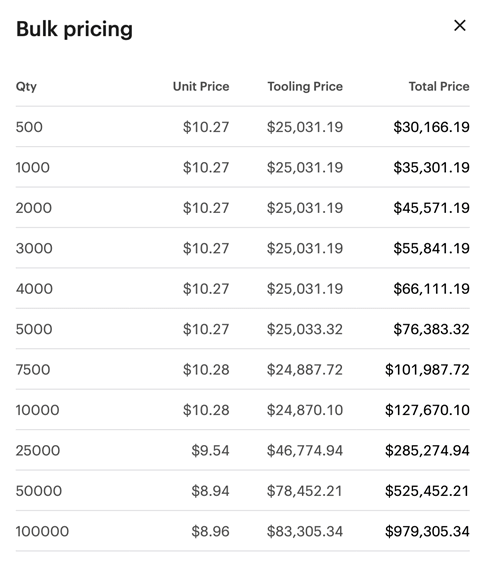Determine Manufacturing Cost Through Sheet Metal Simulation Technology
Sheet metal production is advancing at a fast pace. Today, simulation technology allows new product manufacturers to streamline parts of their manufacturing process while helping them determine the best materials for their goods.
One of the biggest benefits for sheet metal product manufacturers is that simulations allow them to effectively price their goods without having to carry out expensive prototypes. This article discusses the benefits of simulation for cost calculation and how it results in a better product for both end-users and the companies that produce them.
How to Calculate Manufacturing Costs
In high volume manufacturing, the total manufacturing cost has two main elements: tooling and piece cost (or unit price). The cost of each is very dependent on manufacturing volume or quantity.
Here is an example of how the costs of both tooling and unit cost, vary with quantity:

Example manufacturing costs, based on volume.
This example is typical for sheet metal parts that will be produced in a stamping press, without hand work. The tooling cost increases with volume, but the unit cost decreases as volume increases. It’s clear that increasing volume allows lower cost per part, but the tooling cost must be increased to ensure such tooling can reliably produce a larger volume of parts.
The additional tooling cost is required because of the need to include items such as hardening or special tool surface coatings, which allow the tool to produce more parts without wearing out.
Additional tooling stages (such as hardened trim tools) are required for increasing volumes, in place of 3D laser cut blanks, for example. For the largest volumes, the tooling type needs to be of high-speed nature, which means automated transfer tooling or high efficient progression tooling.
In the case of progression tooling, additional material is needed as part of the automatic transfer mechanism (or “the strip”) since the sheet metal blank remains connected in all stations, to allow high-speed transfer of the part from one tool to the next.
Of course, for any given sheet metal part, the required blank shape and size must also be known but it is almost never the case that the minimum blank material is the correct amount of material needed to manufacture the part.
Therefore, the total manufacturing cost is highly dependent on knowing the following parameters (minimum):
- Required volume of parts (often expressed as parts per year, in the automotive industry)
- Minimum blank size
- Scrap/waste in addition to the minimum blank size
- Type of tooling eg: transfer or progression tooling
- The exact number and total cutting length of trimming stages
- The exact number and type of forming stages, including restrike or springback compensation
- Required forming forces for each tooling stage, which determines press size
- Friction requirements for each tooling stage, which determines tool coatings and finish
A cost must be assigned to each of these items. To do this quickly and accurately, simulation is
used.
Only advanced simulation software can quickly and accurately determine the above parameters for complex sheet metal products, using the 3D model of the product as the starting point.
Each company will have a different cost basis for each item in the above list, but without accurate information for each item, calculating the total manufacturing cost incorrectly without simulation could be a costly mistake.
Related Article: https://stampingsimulation.com/round-peg-fits-square-hole-ustun-makina/
